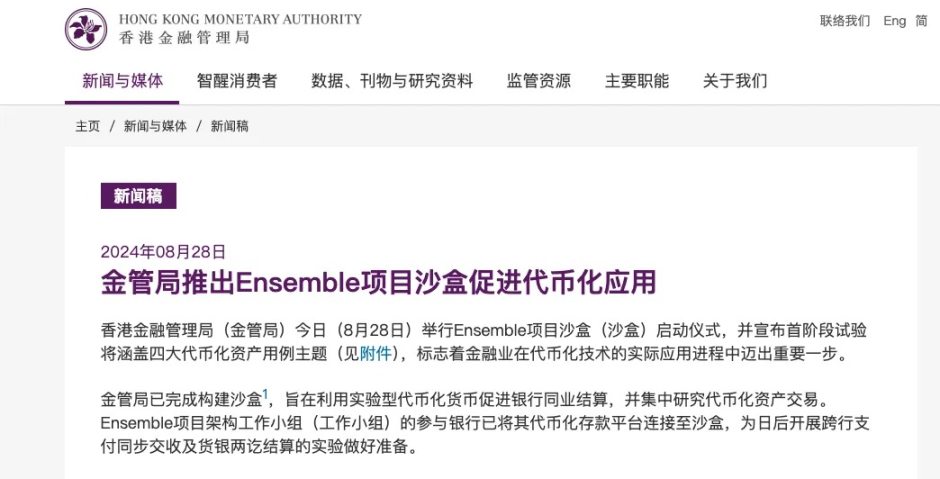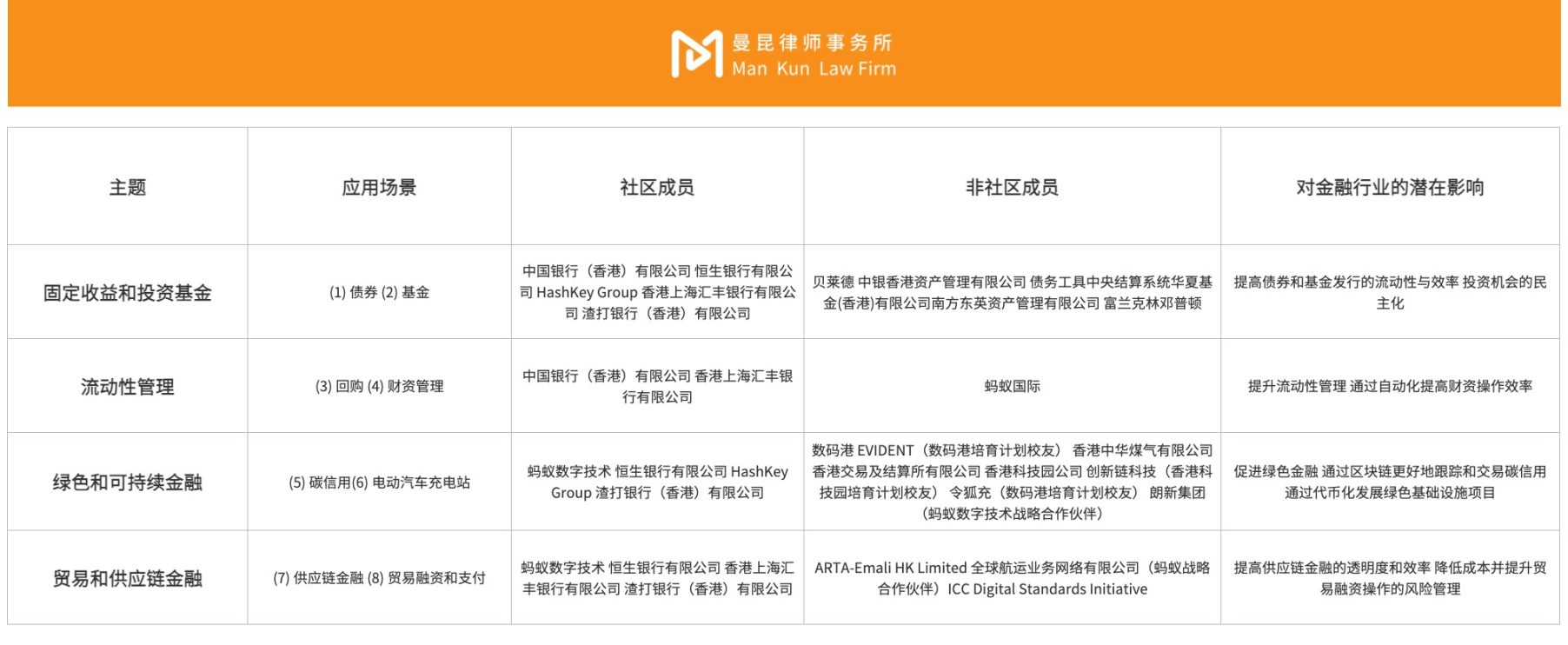Ensemble Sandbox is a microcosm of the future digital financial landscape.
Author: Bai Zhen, Mannkin Law Firm, Hong Kong Office
On August 28, 2024, the Hong Kong Monetary Authority (HKMA) took another step to promote cryptographic financial innovation by launching a sandbox program called "Ensemble." According to the HKMA press release, the Ensemble project sandbox aims to use experimental tokenized currency to promote interbank settlement and focus on the study of tokenized asset trading.

* Image source: HKMA official website
At the same time, the HKMA announced that the first phase of the experiment will cover four major tokenized asset use case themes, including: fixed income and investment funds, liquidity management, green and sustainable finance, and trade and supply chain finance.
This news has sparked discussions and attention from Web3 practitioners regarding the RWA track in Hong Kong. Mannkin Law Firm has written this article to share its analysis of the sandbox itself and its impact on the industry.
Vision behind Ensemble
It is no exaggeration to say that this plan marks an important milestone in the development of the digital asset ecosystem in Hong Kong, bringing revolutionary changes to the conduct and regulation of financial transactions. The sandbox envisioned by the HKMA is not only a regulatory tool, but also a dynamic testing platform where innovative ideas are transformed into practical solutions. The vision of Ensemble is closely linked to the technical testing phase, with each test serving as a cornerstone to achieve this broader goal.

In recent years, the HKMA has been very active in exploring the potential of digital currencies and new technologies, especially in the field of central bank digital currencies (CBDC), with efforts such as the mBridge project and e-HKD being particularly notable. However, the HKMA also recognizes that the future of the financial world will not be shaped solely by CBDCs. Tokenization, utilizing blockchain technology to digitize assets, is another key piece of this puzzle. By tokenizing commercial bank currencies and real assets, financial transactions can be simplified, creating new opportunities for innovation. Therefore, integrating CBDCs and asset tokenization into the Ensemble sandbox reflects the HKMA's clear strategy to explore the synergistic effects of these innovations, ensuring that these technologies complement each other in creating a more robust and versatile digital financial ecosystem.
The main purposes of Ensemble can be summarized as follows, with each purpose aimed at advancing the understanding and application of tokenization in finance.
- Exploring use cases: Allowing participants to experiment with tokenized assets in a secure environment, exploring various applications without the immediate pressure of full implementation.
- Technical testing: Testing the compatibility of different digital assets, tokenized deposits, and CBDCs. This stage is crucial for ensuring the robustness of the technology and preparing for broader adoption.
- Setting industry standards: Establishing common industry benchmarks for tokenization, which is crucial as technology evolves. By promoting the entire lifecycle of tokenized asset transactions, from creation to trading to payment and settlement, the sandbox helps participants understand the practical impact of tokenization and its potential to address real-world challenges, such as its application in supply chain finance.
- Addressing real-world challenges: The sandbox promotes innovative applications aimed at addressing actual challenges in the finance sector, especially in areas such as trade and supply chain finance. By addressing these pain points, Ensemble is helping to make tokenization a viable option for businesses.
Four Major Themes of Asset Tokenization
The Ensemble sandbox project by the HKMA has identified four key themes for initial experiments, each representing an important part of the financial sector. These main themes were carefully chosen because they represent the key areas where asset tokenization could have the most profound impact.
- Fixed income and investment funds: This theme explores how tokenization can change traditional investment tools, making them more accessible and efficient. By creating digital representations of bonds or investment funds, the financial industry can reduce settlement times, lower costs, and enhance liquidity, providing new opportunities for investors.
- Liquidity management: Tokenization has the potential to fundamentally change liquidity management by allowing assets to be divided and traded on digital platforms. This could lead to more dynamic and efficient liquidity management, especially in situations where rapid access to funds is crucial.
- Green and sustainable finance: The HKMA also focuses on how tokenization can support green and sustainable finance initiatives. By tokenizing assets such as green bonds or carbon credits, the financial sector can enhance transparency and traceability, ensuring that funds are effectively allocated to environmental projects.
- Trade and supply chain finance: Tokenization can address major pain points in trade and supply chain finance by simplifying the process of tracking and transferring ownership of goods and financial assets. This can improve the efficiency and transparency of supply chains, reduce fraud risks, and enhance overall market confidence.

Tokenization of Real Assets
Imagine owning a real estate property worth $1 million. Through tokenization, you can convert the property into 1 million digital tokens, with each token representing a small portion of ownership. These tokens can be traded, sold, or even used as collateral for other financial transactions within the blockchain ecosystem. They can be seen as a digital representation of a real asset, easily tradable, transferable, or used in various financial transactions within a secure decentralized network.
Tokenization of real assets is one of the key experimental areas of the Ensemble sandbox. Through experiments with real assets, the sandbox can test the practicality and advantages of introducing traditional assets into the digital realm. This not only aligns with the vision of the HKMA but also lays the foundation for future developments in the broader financial landscape, such as:
- Enhanced liquidity: Traditional real assets like real estate often have poor liquidity, meaning they may be difficult to sell quickly. Tokenization allows these assets to be divided into smaller tokens that are easier to trade, improving liquidity.
- Increased accessibility: Tokenization makes asset categories previously inaccessible to many investors more widely available. For example, individuals with limited capital can purchase a small portion of high-value assets (such as real estate) through tokens.
- Reduced transaction costs: Blockchain technology can reduce the costs of trading and transferring assets by eliminating the need for intermediaries such as brokers or custodians.
Global Collaboration and Future Prospects
Perhaps one of the most exciting aspects of Ensemble is its potential to facilitate cross-border payments. Currently, the HKMA has demonstrated this capability through successful collaboration with a French bank, connecting their sandbox systems to execute atomic cross-border settlements. This is just one example of Ensemble laying the groundwork for a more interconnected global financial system.
In conclusion, Ensemble Sandbox is a microcosm of the future digital financial landscape. By combining cutting-edge technology, strategic partnerships, and practical applications, it not only advances the vision of the HKMA but also sets global standards for digital asset innovation.
免责声明:本文章仅代表作者个人观点,不代表本平台的立场和观点。本文章仅供信息分享,不构成对任何人的任何投资建议。用户与作者之间的任何争议,与本平台无关。如网页中刊载的文章或图片涉及侵权,请提供相关的权利证明和身份证明发送邮件到support@aicoin.com,本平台相关工作人员将会进行核查。




